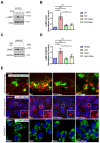Inhibition of PIKfyve Leads to Lysosomal Disorders via Dysregulation of mTOR Signaling
- PMID: 38891085
- PMCID: PMC11171791
- DOI: 10.3390/cells13110953
Inhibition of PIKfyve Leads to Lysosomal Disorders via Dysregulation of mTOR Signaling
Abstract
PIKfyve is an endosomal lipid kinase that synthesizes phosphatidylinositol 3,5-biphosphate from phosphatidylinositol 3-phsphate. Inhibition of PIKfyve activity leads to lysosomal enlargement and cytoplasmic vacuolation, attributed to impaired lysosomal fission processes and homeostasis. However, the precise molecular mechanisms underlying these effects remain a topic of debate. In this study, we present findings from PIKfyve-deficient zebrafish embryos, revealing enlarged macrophages with giant vacuoles reminiscent of lysosomal storage disorders. Treatment with mTOR inhibitors or effective knockout of mTOR partially reverses these abnormalities and extend the lifespan of mutant larvae. Further in vivo and in vitro mechanistic investigations provide evidence that PIKfyve activity is essential for mTOR shutdown during early zebrafish development and in cells cultured under serum-deprived conditions. These findings underscore the critical role of PIKfyve activity in regulating mTOR signaling and suggest potential therapeutic applications of PIKfyve inhibitors for the treatment of lysosomal storage disorders.
Keywords: PIKfyve; lysosome; mTOR; macrophage; vacuolation.
Conflict of interest statement
The authors declare no conflicts of interest.
Figures






Similar articles
-
PIKFYVE inhibition induces endosome- and lysosome-derived vacuole enlargement via ammonium accumulation.J Cell Sci. 2025 Jan 1;138(1):jcs262236. doi: 10.1242/jcs.262236. Epub 2025 Jan 10. J Cell Sci. 2025. PMID: 39588583
-
Akebia saponin E, as a novel PIKfyve inhibitor, induces lysosome-associated cytoplasmic vacuolation to inhibit proliferation of hepatocellular carcinoma cells.J Ethnopharmacol. 2021 Feb 10;266:113446. doi: 10.1016/j.jep.2020.113446. Epub 2020 Oct 5. J Ethnopharmacol. 2021. PMID: 33031902
-
PIKfyve Deficiency in Myeloid Cells Impairs Lysosomal Homeostasis in Macrophages and Promotes Systemic Inflammation in Mice.Mol Cell Biol. 2019 Oct 11;39(21):e00158-19. doi: 10.1128/MCB.00158-19. Print 2019 Nov 1. Mol Cell Biol. 2019. PMID: 31427458 Free PMC article.
-
Autophagy, lipophagy and lysosomal lipid storage disorders.Biochim Biophys Acta. 2016 Apr;1861(4):269-84. doi: 10.1016/j.bbalip.2016.01.006. Epub 2016 Jan 14. Biochim Biophys Acta. 2016. PMID: 26778751 Review.
-
PIKfyve: Partners, significance, debates and paradoxes.Cell Biol Int. 2008 Jun;32(6):591-604. doi: 10.1016/j.cellbi.2008.01.006. Epub 2008 Jan 25. Cell Biol Int. 2008. PMID: 18304842 Free PMC article. Review.
References
-
- Zolov S.N., Bridges D., Zhang Y., Lee W.-W., Riehle E., Verma R., Lenk G.M., Converso-Baran K., Weide T., Albin R.L., et al. In Vivo, Pikfyve Generates PI(3,5)P2, Which Serves as Both a Signaling Lipid and the Major Precursor for PI5P. Proc. Natl. Acad. Sci. USA. 2012;109:17472–17477. doi: 10.1073/pnas.1203106109. - DOI - PMC - PubMed
Publication types
MeSH terms
Substances
Grants and funding
LinkOut - more resources
Full Text Sources
Molecular Biology Databases
Research Materials
Miscellaneous

